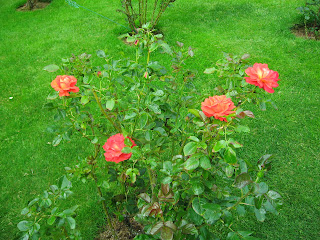Back on July 2, I discovered an interesting growth coming up about 6 inches away from one of my 'Voodoo' rose seedlings. After some thought, I concluded that it must be a sucker coming up from an underground runner. So, it was time to do a little research. 'Voodoo' has both Rosa foetida bicolor (Austrian Copper) and Rosa foetida 'Persian Yellow' among its many ancestors; both of those roses are known to produce suckers. Also, most of our modern hybrid roses undoubtedly have some untraceable Damask and Gallica ancestors -- these "old garden roses" also sucker freely.
There's a lesson in here somewhere. It looks like modern roses grown on their own roots (as seedlings, or even from cuttings) can indeed produce runners and suckers. In these cases, there would be NO alien root stock to blame. In the end, it all depends on the ancestry of the rose bush. So, be careful where you step and be observant out there in your rose garden !
Below are some photos of this "phenom". Note that we have a fully open bloom roughly one month after I discovered the newly emerged sucker. In the 3rd and 4th photos, I am using a 6 inch ruler to show the distance of the sucker from its parent plant as well as the height of this garden surprise.
 |
| July 2, 2012 |
 |
| July 14, 2012 |
 |
| August 3, 2012 |
 |
| August 3, 2012 |
The 'Voodoo'-seedling "parent" of this outgrowth was born on May 27, 2008. Below is a photo of the rose bush in full bloom that I took on July 13th, about 3 weeks ago. You will see 5 canes on this rose bush, and if you look closely between the 4th and 5th canes (and about 6 inches behind the canes -- click on the photo to enlarge it), you will see the sucker starting to establish itself.
 |
| July 13, 2012 |
Update of June 12, 2013: It's time to check on the progress of our little runner, which isn't so little anymore. It now stands 2½ feet tall, is developing its own basal breaks, and is carrying another nice bloom. Not only that, but it now has a "brother", which came up about 2 inches from the main plant and is ready to open a similar bloom.
 |
| June 12, 2013 |
 |
| June 12, 2013 |



















































